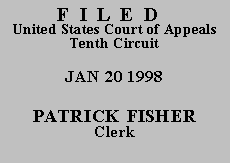

| UNITED STATES OF AMERICA, | |
| Plaintiff - Appellee, | |
| v. | |
| FRANK EDWARD VANN, | |
| Defendant - Appellant. |
Pursuant to a plea agreement, Defendant, Mr. Frank Edward Vann, pled guilty to conspiracy involving the sale of cocaine powder, and he was sentenced to 292 months in prison. Defendant is appealing a four-level enhancement of his offense level for being a leader in an illegal enterprise involving five or more people, pursuant to U. S. Sentencing Guideline § 3B1.1(a). Defendant contends the district court did not make specific findings of fact to support this enhancement. Additionally, Defendant maintains the district court's conclusion that Defendant was a leader is based on unreliable information and unsupported facts contained in the presentence report.
The district court did make explicit findings regarding Defendant's role in the conspiracy:
The Court found by a preponderance of the evidence, the defendant was a leader in this crack cocaine conspiracy . . . [and] in considering a number of factors, found that the defendant exercised decision making [sic] authority over others as well as planning and organizing the same. The Court observed that the defendant recruited other participants and accomplices to do this, as well as claiming a larger share of the proceeds. The Court further found that the defendant exercised a leadership role in the criminal activity in this case, that he directed others, ordered others in matters concerning picking up and splitting the proceeds, and instructed others as to where the money from the illegal activity was to be sent.
R., Vol. I at 120 (Findings, United States v. Vann, CR 97-00017-002-M at 3).
Defendant challenges the determination of the district court that he was a leader of a criminal enterprise because these findings: (1) do not state specifically who the Defendant directed; (2) do not specify the relative share of the proceeds Defendant received; and (3) do not specify what evidence the court relied upon when determining that Defendant was a leader. See Appellant's Br. at 14-16. Defendant maintains that these findings are, therefore, not specific enough to support the enhancement of his offense level. See id. at 16. Under this court's holdings in United States v. Melendez-Garcia, 28 F.3d 1046, 1056 (10th Cir. 1994), and United States v. Pedraza, 27 F.3d 1515, 1530-31 (10th Cir. 1994), the district court's findings are specific enough to withstand challenge.
We "review a district court's factual findings supporting a sentence enhancement for clear error . . . [and t]he district court's application of those facts to the sentencing guidelines is reviewed de novo." United States v. Valdez-Arieta, 127 F.3d 1267, 1270 (10th Cir. 1997) (citations omitted).
The district court's determination that Defendant was a leader of the conspiracy clearly conforms to our previous decisions. See, e.g., United States v. Smith, No. 96-6377, 1997 WL 768372, at *5-6 (10th Cir. Dec. 15, 1997); United States v. Knox, 124 F.3d 1360, 1366 (10th Cir. 1997); United States v. Lacey, 86 F.3d 956, 967 (10th Cir.), cert. denied, 117 S. Ct. 331 (1996); United States v. Edwards, 69 F.3d 419, 439-40 (10th Cir. 1995); United States v. Robertson, 45 F.3d 1423, 1448-49 (10th Cir. 1995); see also United States v. Allemand, 34 F.3d 923, 931-32 (10th Cir. 1994) (affirming a sentence enhancement under U.S.S.G. 3B1.1(b) and stating: "[A]lthough the evidence of Thomas's supervisory role is sparse, we cannot say that the court clearly erred by finding that Thomas was a manager or supervisor.").
Defendant argues that there is not enough reliable evidence in the record to support a determination that he was a leader of the illegal enterprise. This court reviews for clear error whether a sentence enhancement under U.S.S.G. § 3B1.1 is supported by a preponderance of the evidence. See United States v. Guadalupe, 979 F.2d 790, 795 (10th Cir. 1992). There is clearly enough evidence in the record for the district court to have found that Defendant was a leader in the conspiracy. See United States v. Bernaugh, 969 F.2d 858, 863 (10th Cir. 1992) (holding that the court can use any reliable evidence in enhancing the sentence, including hearsay testimony from another's trial). The record includes the testimony of several co-conspirators, presented at the trial of Defendant's co-leader in the conspiracy, which specifically detail Defendant's role in the illegal enterprise. See, e.g., R., Vol. II at 93-96, 112, 117; Vol. III at 231-32, 268-69. It is not necessary for the court to detail the specific amounts of money that Defendant received from the drug sales; there is sufficient evidence in the record to support the factual findings that Defendant directed his co-conspirators as to the dispersal of the conspiracy's proceeds and that he received a larger share of the proceeds than his co-conspirators. See R., Vol. II at 112, 117; Vol. III at 228, 268-69.
Finding no error in the decision of the district court to apply the offense level enhancement, we AFFIRM the sentence imposed.
AFFIRMED.
Entered for the Court
Monroe G. McKay
Circuit Judge
*. This order and judgment is not binding precedent, except under the doctrines of law of the case, res judicata, and collateral estoppel. The court generally disfavors the citation of orders and judgments; nevertheless, an order and judgment may be cited under the terms and conditions of 10th Cir. R. 36.3.